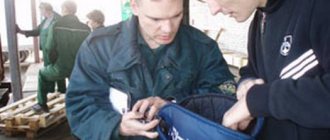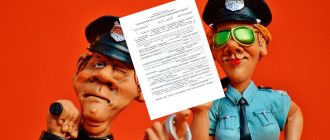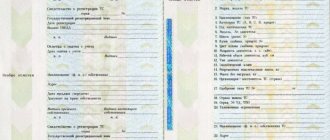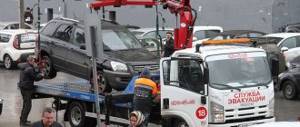What is a vehicle inspection?
After the inspector accepts the application and checks whether all documents are in place, the citizen will go to the observation deck. A traffic police officer checks the numbers on the engine and chassis with the data on the vehicle title. If a citizen cannot deliver the car himself, it is necessary to provide a technical inspection report. This document will be valid for only twenty days. The act does not relieve the obligation to verify numbers. Much attention is paid to used cars. If the previous owner changed the engine or changed any other units in the design, then it had to be registered. Very often they are refused due to the presence of tint. If the car is recognized as post-accident, then most likely difficulties will also arise.
If the actual data from the car does not coincide with the data on the PTS, if the numbers are not readable on the body and engine, an employee of the State Traffic Inspectorate will order a forensic examination.
How to prepare for the examination?
- Wash the car;
- Remove unnecessary things;
- See where the VIN number is located and whether it is legible;
- If the number has suffered from corrosion, it must be cleaned with special means.
You can undergo a similar check before purchasing a car. A number of organizations conduct such examinations and issue conclusions on the authenticity of vehicle license plates.
The inspection is carried out at the traffic police site. The owner must come to the place, turn off the engine and open the hood. The inspector will check the documents in the database of cars that are listed as stolen, and then inspect the car. The vehicle is also checked against the bailiff database to determine whether it has been seized. The inspection procedure is not only a visual inspection, but also a verification of numbers in accordance with the PTS. If the inspector discovers that the numbers and symbols are not readable, this fact is noted in the application.
Difference between concepts
It is not difficult to understand the differences between inspection and inspection if you delve into the essence of the concepts themselves. They are really different, and it is important to consider what exact concept the inspector uses when presenting such demands, and whether he actually carries out the procedure within the scope of his authority, without violating the driver’s rights.
To understand the difference between inspection and search of a car, you should pay attention to the main documents regulating this issue. Here we are talking about the code of administrative offenses, as well as the administrative regulations provided for by the Ministry of Internal Affairs. Here you should look at article 27.9 and paragraph 197, respectively.
Based on these legal documents, we can understand the following:
- An inspection is a purely visual examination of the vehicle itself, as well as what is transported in it;
- An inspection is considered to be a direct examination of the vehicle, as well as the cargo being transported.
Don't forget about the concept of a search. This is a more serious procedure that requires compelling reasons. It involves studying the contents of the car in order to identify certain objects, things, cargo, etc.
Based on the concepts considered, one still gets the impression that they are identical to each other and do not differ significantly in anything.
But there really is a difference. And it consists in the following. If a vehicle is being inspected, the inspector has the legal right to exclusively visually inspect the vehicle and its contents. That is, he looks at what is directly in the cabin or in the luggage compartment. The key difference is the fact that the inspection already involves direct contact with the car and things. In fact, the traffic police officer gets the right to touch things.
One extremely important point should be taken into account here. Even when a search is carried out that allows you to touch the car and the cargo being transported, the inspector does not have the legal right to open your bags and suitcases. Such things, the contents of which are closed, act as the personal property of the driver or passengers of his car. To open the bag, the inspector must present compelling arguments and compelling reasons.
An inspection of personal belongings is considered to be the checking and opening of bags and various things that do not belong to the vehicle itself. If the inspector requires the driver to take off his clothes, turn out all his pockets and show their contents, then we are talking about a personal search. These are two different concepts that should also be kept in mind.
What is it for?
These requirements must be met, otherwise registration will be denied. A car inspection is primarily necessary to check safety. Technical changes affect the condition of the vehicle and may lead to poor handling. The car must be in good working order, otherwise there is a chance of getting into an accident.
The main reason for refusal of registration after inspection of the car is non-conformity of designs, namely:
- Low-slung vehicles;
- Roaring muffler;
- Other technical malfunctions.
It is necessary to prepare for a vehicle inspection. You need to remove the tint from the windshield and front door windows. You also need to make sure that the radii of the disks meet the operating requirements of the car. Pay attention to the condition of the body and VIN code. There should be no problems reading it. If necessary, you need to replace the steering wheel with the original one.
If there are technical violations, it is better to get rid of them and replace them with standard factory parts. Check the condition of the rubber - wear limit is at least 1.6 mm. If the steering wheel does not match the model, then it also needs to be changed.
If the driver has a desire to transform the car, it is better to contact a licensed center, where they will carry out repairs without violating the rules of vehicle operation. The examination takes only twenty minutes, but usually even less. The test results will be valid for 30 days.
After the inspection has been carried out, the fact is noted in the statement. If the numbers match and there are no questions about the car, then the inspection is considered completed and the owner can receive documents. If there is any doubt, the car is sent for a special examination. The goal is to make sure that the car was not stolen and assembled from parts from broken and stolen cars.
What do they check when registering a car with the traffic police?
They check VIN codes, body numbers, chassis numbers with documents;- The degree of glass tinting is checked;
- Check that the steering mechanism complies with the factory parameters;
- Checking the front and rear headlights of models according to GOST.
It is because of these requirements that registration may be denied. It is also worth remembering that if the car is equipped with gas equipment, then you must have a permit and the inspector may require documents for installation.
First aid kit and warning triangles are checked during inspection. During the inspection, the technical condition of the car is assessed for compliance with GOST. Car inspection is a complex procedure aimed at assessing the legality of the vehicle.
How to get a car checked?
Registration of a car is not complete without a preliminary inspection procedure. If the car is not running and it is not possible to deliver it to the department, you need to contact the State Traffic Inspectorate office or order an independent on-site inspection from an expert.
A standard inspection includes a general drive of the car through the database to determine violations of the law, such as theft, arrest. As a result, all data is entered into the report: date, place, position of the person who conducted the inspection. The act is valid for 30 days.
Where does the test take place?
The inspection is carried out at the traffic police registration office on the observation deck. It is possible to undergo an on-site inspection. When inspecting a vehicle before registering it, an employee checks the ownership documents and the vehicle. They pay attention not only to the technical condition, but also to the owner’s details and details.
The examination, in turn, is carried out by any certified institution. You can contact independent experts or staff criminologists of the Ministry of Internal Affairs. A car enthusiast can choose any establishment based on the objectives. If the car was involved in crimes, the examination is carried out at the Internal Affairs Directorate. The results are reflected in the car's passport.
What documents will be needed to pass?
Documents for registration:
- PTS;
- PrEP;
- Other documents on ownership;
- Receipt for payment of state duty;
- OSAGO policy;
- Passport.
You will also need to write an application.
How to submit documents to the traffic police?
According to the law, you need to register a car within ten days. The new owner must come to the registration authorities and present the vehicle for inspection. It is impossible to register a car without inspection, so you need to collect a package of documents and prepare an application. This can be done in person at the department or make an appointment through the official website of the State Traffic Safety Inspectorate or State Services.
When will the vehicle condition inspection certificate be issued and what is its validity period?
After the car has been inspected, a special report is drawn up. It indicates that an inspection of the technical condition of the car was carried out. The act records not only the fact of the examination itself, but also information about the results. Information about the condition of the car is recorded, and based on this data, a decision is made whether the car can be used. The report must be signed by everyone who conducted the inspection. The document is valid for 30 days and must be served upon completion of the inspection.
Vehicle inspection
In accordance with paragraph 6.10 of the new regulations of the Ministry of Internal Affairs, inspectors and other representatives of internal affairs bodies are given the right to carry out this action. The Regulations prescribe what vehicle inspection is, the procedure for carrying it out, as well as the reasons for its implementation.
In fact, the inspection consists of examining its interior, including the interior of the car, its trunk and the engine compartment. At the same time, the traffic police inspector has the right to touch things, open the doors and hood, use the car controls (but not to drive the car somewhere, but simply, for example, turn the ignition on/off, pull out the cigarette lighter, open the glove compartment, etc.).
During the inspection, the traffic police officer has the right to touch and move personal belongings, but cannot open them or rummage through them, otherwise this becomes a personal search of the belongings of the driver or passengers. And this is no longer the same as searching a car. Each of these operations has its own reasons, its own documents and its own procedure for implementation.
In particular, an inspection requires the mandatory execution of an inspection protocol.
What are the grounds for inspection?
Let's start with the fact that the policeman does not have the right to just stop the first vehicle he comes across and say that he wants to conduct a search because something seemed suspicious to him in the driver’s behavior or something else. To carry out this procedure, clear grounds are needed, and they are indicated in paragraph 202 of Order No. 664, which puts into effect the regulations of the Ministry of Internal Affairs.
So, there may be the following reasons for inspection, and there are only 3 of them:
- checking the available materials of various cases that the vehicle may contain things prohibited by the Criminal Code (weapons, bombs, drugs, etc.),
- checking the available materials of various cases that the vehicle may contain objects or things that are involved in any administrative offense (removable tinting removed by a cunning driver, ignition units for illegal xenon lights when this is prohibited, etc.),
- detaining persons in a car: either the driver or passengers, when a representative of the law has information that they are wanted or have committed an offense.
This is an exhaustive list of reasons.
But what is meant by “verification of information” in these reasons?! This is nothing more than orientation towards the driver, passengers or directly towards the car itself. That is, if your car matches the description of the one that is in this orientation, then the traffic police inspector has the right to conduct an inspection of the vehicle.
But there is also bad news for drivers: the inspector is not obliged to report and, moreover, show certain orientations to the driver. Although he is required to not impede road users from obtaining any information concerning them, this does not mean that he must hand such information over on a platter. Non-obstruction in this case means that he must indicate that there is an orientation and that it lies, for example, at the nearest traffic police post as a document.
Orientation can also be oral. After all, imagine the situation: if something valuable was stolen from you, and you remembered the details of the car in which the robber drove off, and quickly reported it to the police, then it will be better for you when, in order to carry out an inspection in search of the stolen property, the traffic police inspector who stopped car according to its orientation, will have the right to conduct an inspection without showing such orientations to the driver.
Search rules
The search is carried out either in the presence of 2 witnesses, or the latter are replaced by video recording, when everything is recorded on a video camera.
The inspector decides what exactly will indicate the inspection. If these are witnesses, then their data must be reflected in the appropriate inspection protocol, and there must be at least 2 people (clause 203 of the regulations). A note about the video recording is also made in this document.
But nothing prohibits a traffic police officer from making a video recording, even if there are witnesses.
At the same time, as we said in one of our previous articles, you also have the right to cancel the procedure, and the legislation in force for 2021 does not prohibit you from doing this. Moreover, in order to avoid “set-ups”, although this is unlikely, it is better to always carry with you any tool for video recording - at least a mobile phone.
The search must be carried out only in the presence of the driver or owner of the car (clause 204 of the regulations). However, there are exceptions to this rule - these are emergency situations (clause 205). These are cases where there is a significant threat to the safety of others (Article 2.7 of the Administrative Code).
When the vehicle is inspected, both the driver and passengers will be forced to get out of it (clause 207 of the regulations). This is a rule that many people forget about, and thus run the risk of putting themselves under administrative arrest for obstructing the lawful orders of the inspector.
When, during an inspection, an inspector finds objects or things that have signs of a criminal offense, the inspector has no right to do anything against the driver other than not let him go further. In this case, he is obliged to call the criminal task force and hand over the driver to them.
And, perhaps, one of the most important points: during an inspection, the employee cannot remove the trim, plastic components inside the car interior or in its luggage compartment, or disassemble anything under the hood. The inspection is carried out without disturbing the structural composition of the machine. The latter can only be carried out during a search by an investigative team as part of a criminal investigation.
Inspection protocol
It must always be drawn up, except in cases where the driver is detained (and when the decision to detain is made even before the inspection - clause 211 of the regulations).
The following data must be written in the protocol:
- driver data,
- data from the police service representative himself,
- data understandable (if present),
- information about things discovered and/or seized during the search,
- date and time when the vehicle was searched by a traffic police officer,
- signatures of all inspection participants.
What violations do inspectors most often commit during an inspection?
The most common violations include the following:
- lack of inspection protocol; even more often, inspectors conduct an inspection, substituting concepts and calling it an inspection, although in fact they are rummaging through personal belongings (carrying out an inspection of the personal belongings of passengers or the driver);
- the absence of both witnesses and video recordings of this procedural event (and miraculously, data and signatures of witnesses appear in the protocol later);
- very often procedural violations are made regarding the data entered into the inspection protocol - data is incorrectly indicated, unnecessary notes are made, etc.;
- the inspector may prohibit the driver from filming the process, thereby breaking the law;
- lack of grounds for carrying out a search, as well as grounds invented by the police - therefore, deception of the driver.
In what cases can an additional examination be ordered?
After purchasing a car, the new owner must register the car. If it is new, then there will be no problems, but when buying a used one, you can discover an unpleasant past. When registering, in addition to inspection, an examination of the vehicle may be required. If during inspection an employee notices violations, registration will be denied.
After the inspection has been completed, the inspector can order an examination. Usually it is necessary if the vehicle is involved in an investigation, the numbers in the unit code are not readable, there are suspicions that the car is counterfeit, or the license plate is damaged.
A car enthusiast may also require an examination. If a car is assembled by a citizen from separate units, then an examination is mandatory. If the driver believes that there are no grounds for conducting an examination, it is possible to appeal the decision in court, but this can only be done after a written justification from the traffic police. If there are no documents, you need to contact the prosecutor's office. Another option for resolving the conflict is also proposed if no violations are identified during the examination. You can go to court because the traffic police officers exceeded their powers. During the examination, the technical condition of the car is checked, the authenticity of the body numbers is assessed, documents are checked, and the vehicle is found from databases.
| Did not find an answer to your question? Call a lawyer! Moscow: +7 (499) 110-89-42 St. Petersburg: +7 (812) 385-56-34 Russia: +7 (499) 755-96-84 |
Motor inspection
Separately, I would like to note the inspection of the engine. At the moment, the engine is not a mandatory inspection element, and most likely they will not look at its number. But here’s what you need to understand: if your car is not equipped with a “native” engine, but, for example, a more powerful one from another manufacturer, then you will also be denied registration; there have already been similar cases.
When buying a car, pay attention to the engine; if you have any doubts about the technical condition of the car, negotiate with the seller, take it for service, or better yet, look at other options. The secondary market is now overflowing with a huge number of different cars; you definitely won’t be left without a car.
Friends, be extremely careful when buying a car. It’s better to choose, as they say, a “naked” car, let it be on stock wheels, with a factory engine, without tinting, and of course, legally clean. And then you won’t have any problems with registration.
If you liked the article, I suggest you subscribe to blog updates to stay up to date with the latest automotive topics.
Share this post
- Related Posts
- Electronic OSAGO policy
- How to inherit a car
- We exchange an old car for a new one: TRADE-IN
- How to scrap a car and get a discount on buying a new one
- Car rental agreement
- Which is better to buy a thickness gauge for inspecting a car?









